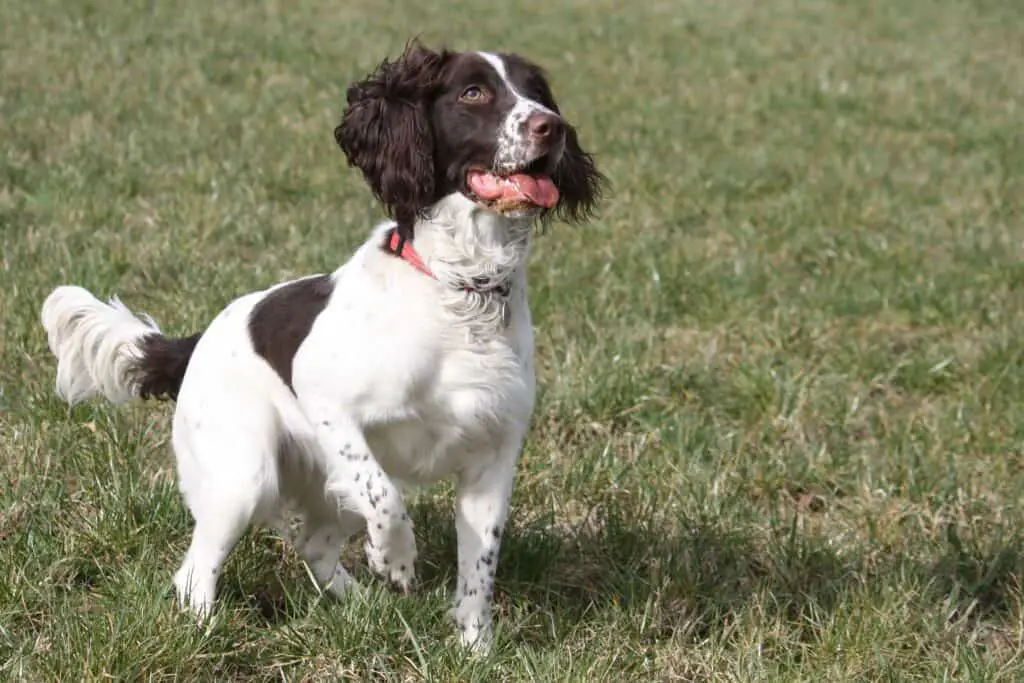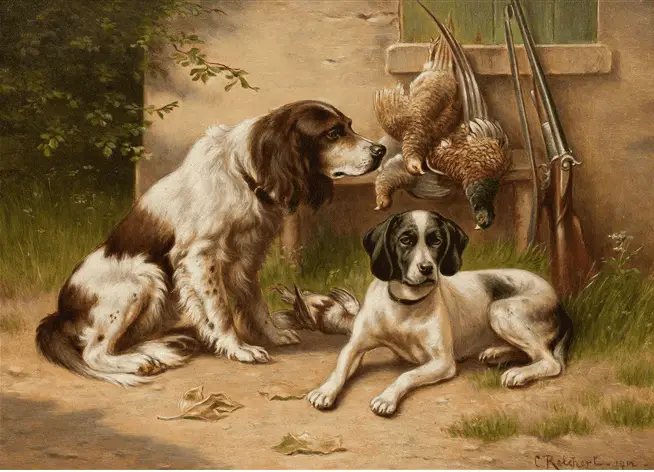Our website is supported by our users. We sometimes earn money when you click an affiliate link and make a purchase. This is at no extra cost to you and helps us to create quality content. For all that have shown us such wonderful support, we thank you from the bottom of our hearts!
The English Springer Spaniel, often simply referred to as a Springer, is a medium-sized breed renowned for its friendly and affectionate nature, making it a popular choice as a family pet.
Not only are they loyal companions, but they also exhibit a keen intelligence and an eagerness to please, traits that make them relatively straightforward to train.
As a member of the sporting group, Springers are gifted with remarkable stamina and energy, characteristics that have historically made them valuable as working dogs, particularly in hunting and retrieving.

Owning an English Springer Spaniel provides a unique experience that combines the joy of an active outdoor companion with the warmth of a good-natured indoor family member.
They thrive on human interaction and are known for their playful spirit and devoted personality.
However, prospective owners should be aware of the breed’s exercise needs and grooming requirements.
Regular exercise is crucial to keeping a Springer physically fit and mentally stimulated, while routine grooming helps maintain their medium-length, feathered coat.
Key Takeaways
- The English Springer Spaniel is an affectionate and friendly breed, ideal for family life.
- They require regular exercise and consistent training to maintain their mental and physical health.
- Grooming is essential for their medium-length coat to keep it in good condition.
History of the English Springer Spaniel
The English Springer Spaniel, a member of the spaniel group, boasts a rich history tied to hunting and companionship.
You can see depictions of dogs resembling the English Springer Spaniel in 16th-century artwork, but it’s in the early 19th century where your breed’s history becomes more distinct.

Initially, English Springer Spaniels were classified with English Cocker Spaniels but were distinguished by size; the larger pups became known as Springers.
You might be surprised to find that there are two types of English Springer Spaniel.
The English Springer Spaniel breed is often divided into two distinct types: the “show” or bench type and the “field” or working type.
The show type is bred primarily for conformation to breed standards, emphasizing physical appearance and adherence to set criteria in competitions.
These Springer Spaniels typically have a more refined appearance with longer coats, and their temperament may lean towards being companions.
On the other hand, field-bred Springers were bred with a focus on working abilities, particularly in hunting and retrieving.
These dogs often have a more functional, athletic build, with shorter coats to reduce maintenance in the field.
While both types share the same breed standard, the emphasis on specific traits diverges based on their intended roles, showcasing the versatility of the English Springer Spaniel as both a skilled working dog and a beloved companion.
Your breed gained formal recognition when the Kennel Club of England separated the Springer from the Cocker Spaniel in 1902, with a defining characteristic being the former’s ability to “spring” game.
The English Springer Spaniel is separate from the Welsh Springer Spaniel, which is a different breed.
Across the Atlantic, the first English Springer Spaniel of direct lineage arrived in North America in 1913, imported to Canada from England.
Within a decade, these sprightly spaniels gained significant popularity and were registered by the American Kennel Club.
| Timeline Event | Year |
|---|---|
| Kennel Club recognizes the breed separately | 1902 |
| First direct lineage Springer arrives in America | 1913 |
| American Kennel Club registration | Early 1920s |
Reflecting their Norfolk ancestors, the English Springer Spaniels you know today retain the hardy constitution and agility required for a full day in the field.
They have become well-loved for their high energy and friendly demeanor as much as their field abilities.
In fact, Oprah Winfrey has two of them named Sunny and Lauren that she rescued.
Physical Characteristics of the English Springer Spaniel
When considering the English Springer Spaniel, your attention to their distinct physical characteristics will help you appreciate this breed’s appearance, from their balanced body and glossy coat to their lively gait.
Height Male
On average, males stand about 19 to 20 inches tall.
Height Female
Females are generally the same height as males, ranging from 19 to 20 inches.
Weight Male
A healthy males typically weigh between 40 and 50 pounds.
Weight Female
Females have a weight range similar to males, also between 40 to 50 pounds.
Eye Colors
You’ll find these dogs with expressive eyes in shades of hazel, brown, or dark brown.

Coat Colors
Their coats display various colors, predominantly liver, black, and white or combinations thereof.
Coat Types
Their coat is medium-length, either flat or wavy, with a glossy topcoat and a soft, profuse undercoat.
Feathering is often found on their ears, legs, and chest. They are only moderate shedders.
Body
Your English Springer Spaniel will have a compact, strong body showing both energy and stamina, key attributes for their historical hunting roles.
They exhibit a balanced stature with quite a bit of bone and large paws.
Life Expectancy
With proper care, you can expect your English Springer Spaniel to have a life expectancy of around 12 to 14 years, sharing many active, healthy years with you.
Temperament & Training of the English Springer Spaniel
Temperament:
English Springer Spaniels are known for their friendly and outgoing personality.
They generally exhibit a high energy level and a playful nature, making them excellent companions for active families.
With their natural agility, they excel in various canine sports and activities. As with all breeds, monitor them around young children.
They are eager to please, which alongside their intelligence, makes them easy to train in comparison to many other breeds.
However, without regular mental stimulation and exercise, their energy may lead to undesirable behavior.
Training:
- Early Socialization:
- Expose your English Springer Spaniel to different environments, people, children, and other pets from a young age.
- This helps develop a well-rounded and social dog.
- Consistent Obedience Training:
- They respond well to positive reinforcement methods, such as treats and praise.
- This breed is often responsive and can learn quickly with the right approach.
- Exercise:
- Adequate daily exercise is crucial, as it helps to manage their barking tendencies and maintain good behavior.
- Agility Training:
- They are natural athletes; engaging in agility training can provide both exercise and mental stimulation.
Remember:
- Be patient and consistent with your training sessions.
- Recognize their need for companionship; they thrive on interaction with their human family.
- Monitor their interaction with cats and small animals due to their hunting instincts, even though they’re typically good with other pets.
By catering to their temperament and training needs, you will foster a loyal and joyful relationship with your English Springer Spaniel.
Health Issues of the English Springer Spaniel
Your English Springer Spaniel may be predisposed to specific health issues, so staying informed can help you take proactive measures.
As a breed, they are generally sturdy and lively, but certain conditions are more prevalent in these dogs.
Hip Dysplasia and Elbow Dysplasia
English Springer Spaniels are susceptible to both hip dysplasia and elbow dysplasia, two orthopedic conditions that can impact their mobility and overall well-being.
Hip dysplasia involves an abnormal development of the hip joint, leading to instability and potential joint problems.
Elbow dysplasia, on the other hand, is characterized by malformation and abnormal growth in the elbow joint.
These hereditary conditions are more common in larger breeds, but English Springer Spaniels can be affected due to their genetics and active lifestyle.
Symptoms may include lameness, difficulty rising, and reluctance to engage in physical activities.
Responsible breeding practices, which involve screening breeding dogs for both hip and elbow dysplasia, are essential for minimizing the prevalence of these conditions in the English Springer Spaniel population.
Regular veterinary check-ups and early detection contribute to effective management, ensuring a better quality of life for affected individuals.
Progressive Retinal Atrophy (PRA):
Progressive Retinal Atrophy (PRA) is a hereditary eye disorder that can affect English Springer Spaniels, gradually leading to vision loss.
PRA involves the degeneration of the retina over time, leading to impaired vision and, ultimately, blindness.
This genetic condition has no cure, making early detection crucial for managing the impact on a dog’s quality of life.
Responsible breeding practices, including genetic testing for PRA, play a crucial role in reducing the incidence of this condition within the English Springer Spaniel population.
Regular veterinary eye examinations are essential for monitoring the progression of PRA and implementing strategies to support affected dogs.
While there is no specific treatment for PRA, supportive care and accommodations can be made to enhance the overall well-being of English Springer Spaniels affected by this inherited eye disorder.
Retinal Dysplasia:
Retinal dysplasia is a congenital eye condition that can affect English Springer Spaniels, causing abnormal development of the retina.
This condition may manifest as folds or rosettes in the retinal tissue, potentially leading to visual impairment.
While some dogs with retinal dysplasia may lead normal lives with minimal impact on their vision, others may experience more severe visual deficits.
Responsible breeding practices, including eye examinations and genetic screening, are crucial for minimizing the prevalence of retinal dysplasia in the English Springer Spaniel population.
Regular veterinary eye check-ups aid in early detection and allow for appropriate management strategies to support affected dogs.
While there is no specific cure for retinal dysplasia, supportive care and creating an environment adapted to the dog’s visual needs can enhance their overall quality of life.

Ear Infections:
English Springer Spaniels, with their pendulous ears and active outdoor lifestyle, can be prone to ear infections.
The breed’s floppy ears can trap moisture, creating a favorable environment for the growth of bacteria and yeast.
Regular ear cleaning and inspection are crucial to prevent infections.
Owners should be attentive to signs of ear discomfort, such as scratching, head shaking, or a foul odor.
Gentle cleaning with veterinarian-approved ear solutions and keeping the ears dry can help mitigate the risk of infections.
Prompt veterinary attention is essential if an infection is suspected, as untreated ear issues can lead to pain and potential complications.
Regular grooming practices, coupled with awareness and proactive care, contribute to maintaining the ear health of English Springer Spaniels.
Allergies:
English Springer Spaniels can be susceptible to allergies, which may manifest as skin irritations, itching, ear infections, or gastrointestinal issues.
Allergies in this breed can result from various factors, including food sensitivities, environmental allergens, or genetic predispositions.
Identifying the specific allergen is crucial for effective management.
Owners can implement strategies like hypoallergenic diets, regular grooming to reduce environmental allergens, and providing allergen-free bedding.
Consulting with a veterinarian is essential to determine the best course of action and alleviate discomfort for English Springer Spaniels affected by allergies.
Regular veterinary check-ups play a vital role in monitoring and managing allergy-related issues, ensuring the overall health and well-being of these active and affectionate companions.
Seizures:
Seizures, characterized by abnormal electrical activity in the brain, can affect English Springer Spaniels.
While the breed is not particularly predisposed to seizures, they can occur due to various factors, including epilepsy, toxins, or underlying health conditions.
Seizures may manifest as uncontrollable shaking, loss of consciousness, or altered behavior.
If a seizure occurs, it is crucial for owners to ensure the dog’s safety by removing potential hazards and contacting a veterinarian for guidance.
Diagnosing the underlying cause of seizures involves veterinary examinations and diagnostic tests.
Treatment options may include antiepileptic medications or addressing the specific cause if identified.
Close collaboration with a veterinarian is essential for managing seizures in English Springer Spaniels, and regular check-ups contribute to monitoring their overall neurological health.
Remember, regular vet check-ups and being aware of these common health challenges can greatly assist in the care and happiness of your English Springer Spaniel.
Grooming Your English Springer Spaniel
Proper grooming is essential for your English Springer Spaniel’s health and appearance.
Regular maintenance of their coat, nails, and teeth helps prevent common issues like mats, tangles, and ear infections.
Brushing
Your Springer Spaniel’s coat requires consistent brushing, ideally three times a week, to manage shedding and prevent mats and tangles.
Use a slicker brush or a pin brush for effective results, and always brush in the direction of hair growth.
Bathing
Bathe your spaniel approximately every 6 to 8 weeks, or as needed.
Frequent bathing can strip natural oils from their coat, so it’s important to use a dog-specific shampoo that maintains coat health.
This massager really gets the soap down through all your dog’s thick furn.
Cutting Fur/Hair
Trimming the fur helps manage your Springer Spaniel’s coat length and cleanliness, especially around the feet, ears, and hindquarters.
Special attention should be in keeping the fur short enough to be clean but long enough to protect the skin.
Clipping or Grinding Nails
Keep your dog’s nails trimmed to prevent discomfort and health problems.
Whether clipping or grinding, it should be done regularly to avoid overgrowth that can lead to splitting or cracking.
Clip or grind their nails, usually once or twice a month, being careful not to cut into the quick, which can cause bleeding.
If you accidentally cut the quick, quickly dip their nails in Styptic Powder.
If you are nervous about trimming your dog’s nails, check out our article on How to Grind Your Dog’s Nails or How to Clip Your Dog’s Nails Safely to help you through the procedure.
It’s best to desensitize your dog to to nail trimming to reduce stress.
Start them as young as possible.
Dental Care
To prevent dental issues, brush your Springer Spaniel’s teeth several times a week using canine toothpaste and tootbrush.
This is vital for good health and to prevent the risk of gum disease.
Cleaning Ears
Check and clean your dog’s ears weekly to avoid the risk of ear infections.
Use a soft, damp cloth or a vet-recommended ear cleaner to gently clean the visible part of the interior ear.
Or for ease of use, we like these Pet MD – Dog Ear Cleaner Wipes – Otic Cleanser for Dogs.
Owning an English Springer Spaniel
Owning an English Springer Spaniel combines the joy of a high-energy, sociable dog with responsibilities that include financial costs, training, and maintaining their health.
Cost of Purchase
When purchasing an English Springer Spaniel puppy, you can expect to pay between $500 to $2000.
The price can vary based on the breeder’s reputation, the lineage of the puppy, and whether the puppy has been health tested or received early training.
- Breeder reputation: Highly regarded breeders often charge more but provide assurance of health clearances and pedigree.
- Lineage: Puppies from award-winning lines may be more expensive.
- Health testing: Early health screening adds to the cost but can save you on future medical expenses.
Maintenance Costs
Owning an English Springer Spaniel brings regular maintenance costs, including food, grooming, and medical care. Here is a breakdown:
- High-quality dog food: A monthly budget of approximately $40-$80.
- Grooming costs: Springers need regular grooming; budget around $30-$60 per session.
- Medical costs: Routine medical care can cost up to $700 annually, excluding unexpected health issues.
Other expenses include training and socialization classes, essential for this breed’s temperament and energy levels.
Adopting an English Springer Spaniel
Adopting from a rescue group can be a rewarding alternative to buying a puppy.
Not only do you provide a home to a dog in need, but the cost is often lower, typically running from $100 to $400.
Adult dogs from a rescue are often already trained and socialized, which can mean less upfront work for you.

Finding A Reputable Breeder
To ensure you’re getting the right puppy, it’s important to find responsible breeders.
They should provide health clearances for both parents and allow you to visit and see the conditions in which the puppies are raised.
Key signs of a good breeder include:
- Willingness to answer questions and provide references.
- Commitment to breed standards and improving the breed.
- Providing detailed medical history and allowing access to the puppy’s parents.
Remembering these points will guide you through the process of owning an English Springer Spaniel, from initial costs to the ongoing joy and responsibility of caring for an energetic and loving companion.
Frequently Asked Questions
In this section, you’ll find answers to common inquiries about the English Springer Spaniel, giving you a clearer understanding of this breed’s lifespan, temperament, exercise needs, and grooming requirements.
What is the typical lifespan of an English Springer Spaniel?
The average lifespan of an English Springer Spaniel is between 12 to 14 years, with proper care and a healthy lifestyle.
Are English Springer Spaniel good family pets?
English Springer Spaniels are known for being affectionate and good with children, making them excellent family pets. They thrive on companionship and are happiest when included in family activities.
What are common behavioral issues in English Springer Spaniels?
Some behavioral issues that may arise include separation anxiety and excessive barking.
Training and socialization from a young age can help mitigate these common behavioral issues in English Springer Spaniels.
How much exercise does an English Springer Spaniel require?
English Springer Spaniels are energetic and require regular exercise to maintain their health. They need at least an hour of exercise each day, which can include walks, runs, or playtime.
What is the process for adopting an English Springer Spaniel from a rescue organization?
Adopting from a rescue organization typically involves submitting an application, meeting the dog, and passing a home check. Some rescues also require a trial adoption period before finalizing the adoption.
How much do English Springer Spaniels typically shed?
English Springer Spaniels have a medium-length coat that sheds moderately throughout the year.
During the shedding seasons in spring and fall, they may shed more heavily and will require more frequent grooming.
Conclusion: Bottom Line on the English Springer Spaniel

The English Springer Spaniel stands out as a versatile companion suitable for various roles.
Whether you’re considering this breed for its prowess as a hunting dog or as a family pet, there are several aspects to consider.
Versatility:
- As a hunting breed, they exhibit exceptional stamina and eagerness when working in the field.
- When it comes to home life, they adapt well and show affection, aligning with the role of a family pet.
Energy Levels:
- High energy necessitates ample exercise.
- Without sufficient stimulation, they may resort to destructive behavior rooted in boredom.
Temperament:
- English Springer Spaniels in show lines often display a more relaxed temperament compared to their hunting counterparts.
- Even temperament and sociability with other pets make them an excellent choice for a harmonious household.

Maintenance:
- They require regular grooming due to their feathered coat.
- They thrive best with consistent training and mental engagement.
If your passions include outdoor activities like hunting, where you might be alongside a falcon or hawk, you’ll find a capable and energetic partner in an English Springer Spaniel.
As hunting companions, their innate drive and keen senses make them exceptional.
If you’re seeking an active breed that can keep up with a lively household and double as a trustworthy companion in outdoor pursuits, the English Springer Spaniel may be a fitting choice.
Remember, your commitment to their exercise and company will help prevent undesirable behavior and foster a rewarding relationship.
Please read our Legal Disclaimer








